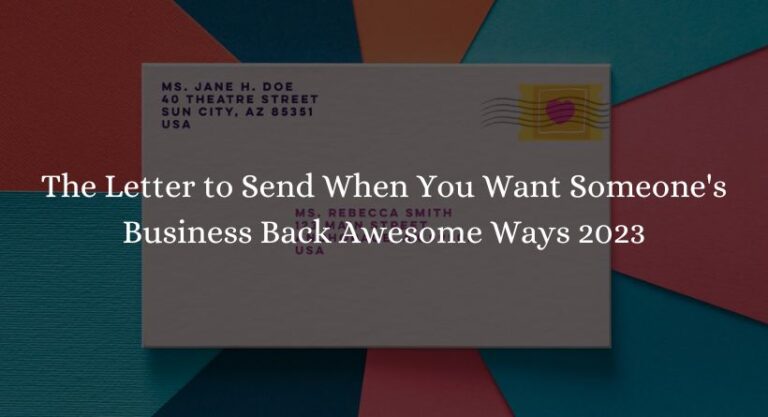Are you facing the challenge of winning back a lost customer? Losing a customer can be disheartening, but it doesn’t mean that all hope is lost. In this blog post, we will explore a powerful solution that can help you regain the attention and trust of those who have walked away from your business.
By crafting a well-crafted letter, you can effectively communicate your sincerity, address any concerns, and make a compelling case for why they should return to doing business with you.
In this article, we will provide you with an actionable guide on how to write a persuasive letter that will rekindle the relationship with your past customers. We will walk you through the key components of an effective letter, provide tips on how to structure your message, and share real-life examples that demonstrate the impact of such an approach.
By the end of this post, you’ll be equipped with the knowledge and tools to craft a compelling letter that has the potential to win back valuable business.
Understanding the Importance of a Persuasive Letter

In today’s competitive business landscape, effective communication plays a pivotal role in winning back customers. When a customer has walked away from your business, a well-crafted letter can be a powerful tool to convey sincerity, address concerns, and make a compelling case for their return.
It goes beyond a simple email or phone call, allowing you to carefully choose your words and structure your message in a persuasive manner.
A persuasive letter holds the potential to reignite the spark of interest and rebuild the trust that may have been eroded. It enables you to directly connect with your past customers, reminding them of the positive experiences they had with your business and highlighting the value you can provide once again.
By empathetically addressing their concerns and offering tailored solutions, you demonstrate your commitment to their satisfaction and show them why choosing your business is the right decision.
Also Read: The Attractive Guide to TV Ads 2023
Components of an Effective Letter
To create a persuasive letter that captures attention and motivates action, it’s essential to understand the key components that make it impactful. Let’s explore these components and how they contribute to the success of your letter:
- Opening: The opening of your letter sets the tone and determines whether the recipient will continue reading. It should be attention-grabbing, personalized, and establish rapport. Consider using a compelling anecdote, a thought-provoking question, or a genuine expression of appreciation to engage the reader from the very beginning.
- Personalization: Tailoring the letter to the individual customer is crucial for making a meaningful connection. Address the recipient by their name, reference past interactions or purchases, and demonstrate that you genuinely understand their unique needs and preferences. This personal touch shows that you value their business and are invested in their satisfaction.
- Acknowledging past experiences: Acknowledging the customer’s previous experiences with your business is essential for building empathy and understanding. Recognize any issues or challenges they may have faced in the past, and sincerely apologize for any shortcomings. This step demonstrates that you take responsibility and are committed to rectifying any concerns.
- Addressing concerns: One of the primary objectives of a persuasive letter is to address the specific concerns that led to the customer’s departure. Take the time to understand their pain points and offer solutions or reassurances that directly address those concerns. By showing that you have taken their feedback to heart and have made improvements, you instill confidence in your ability to deliver a better experience moving forward.
- Value proposition: Highlighting the benefits of returning to your business is crucial for convincing the customer to reconsider their decision. Clearly articulate the unique value and advantages they will receive by choosing your products or services again. Showcase any updates, innovations, or enhancements that have occurred since their departure to demonstrate your commitment to continuous improvement.
- Call to action: Concluding your letter with a clear and compelling call to action encourages the customer to take the next step. Whether it’s scheduling a meeting, making a purchase, or engaging in further communication, provide a specific and easy-to-follow instruction that motivates them to re-engage with your business. Make it convenient for them to respond and provide any necessary contact information or resources.
By structuring your letter with these components in mind, you can create a persuasive message that resonates with your audience and increases the likelihood of winning back their business.
Structuring Your Message

Now that we understand the components of an effective letter, let’s delve into how to structure your message for maximum impact. The structure of your letter should follow a logical flow that keeps the reader engaged and builds a persuasive case for their return.
- Introduction: The introduction sets the stage for the rest of the letter. It should grab the reader’s attention, establish rapport, and create a sense of anticipation. Use this section to connect with the customer emotionally, remind them of their positive experiences with your business, and empathize with any challenges they may have faced.
- Body: The body of the letter is where you present your case and address the concerns that led to the customer’s departure. Break down each concern individually, offering solutions, reassurances, and demonstrating the steps you have taken to improve. Use persuasive language, storytelling, and examples to engage the reader and reinforce the value of returning to your business.
- Closing: The closing of your letter should reinforce the value proposition and the call to action. Summarize the key benefits of returning to your business, reiterate your commitment to their satisfaction, and make a compelling case for why they should choose you. End with a clear and specific call to action that encourages the customer to take the next step.
By structuring your letter in this manner, you can create a compelling narrative that resonates with the reader and increases the chances of winning back their business.
Conclusion
In conclusion, the power of a persuasive letter in winning back business should not be underestimated. Communication plays a vital role in reconnecting with past customers, and a well-crafted letter provides the perfect opportunity to convey sincerity, address concerns, and make a compelling case for their return.
By following the components and structuring your message effectively, you can create a letter that captures attention, resonates with the recipient, and increases the chances of reestablishing a fruitful business relationship.
Remember, each element of the letter serves a purpose, from the attention-grabbing opening to the value proposition and the clear call to action. Personalization and empathy demonstrate your understanding of the customer’s needs and reaffirm your commitment to their satisfaction.
By addressing their concerns and highlighting the benefits of returning to your business, you build a persuasive case that helps them see the value in choosing you once again.
Now it’s time for you to take action. Use the insights and strategies shared in this article to craft your own persuasive letter tailored to your specific audience.
Customize it based on the unique characteristics of your business and the preferences of your customers. Remember to be genuine, empathetic, and focused on providing solutions. With a well-executed persuasive letter, you have the potential to win back valuable customers and reignite your business’s growth.







